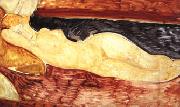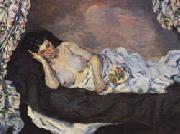
Oil On
Canvas, Real Flavor of Old Masters
|
Amedeo Modigliani
|
|||
|
|
|||
| Italian Expressionist Painter and Sculptor, 1884-1920 Amedeo Clemente Modigliani (July 12, 1884 ?C January 24, 1920) was an Italian artist of Jewish heritage, practicing both painting and sculpture, who pursued his career for the most part in France. Modigliani was born in Livorno (historically referred to in English as Leghorn), in northwestern Italy and began his artistic studies in Italy before moving to Paris in 1906. Influenced by the artists in his circle of friends and associates, by a range of genres and art movements, and by primitive art, Modigliani's œuvre was nonetheless unique and idiosyncratic. He died in Paris of tubercular meningitis, exacerbated by poverty, overworking, and an excessive use of alcohol and narcotics, at the age of 35. | |||
|
|
|||
|
|
Reclining Nude Amedeo Modigliani25.jpg Painting ID:: 10535 Visit European Gallery |
1919, oil on canvas, 28 3/4 x 45 5/8 ins(73x116cm). Galleria Nazionale d'Arte Moderna, Rome. | |
Height Width |
INS/CM |
||
|
X |
|
||
|
|
|||
|
Armand Guillaumin
|
|||
|
|
|||
| French Impressionist Painter, 1841-1927 French painter and lithographer. He grew up in Moulins, but at 16 he returned to Paris to find work. Despite the opposition of his working-class family, he prepared for an artistic career while he supported himself in municipal jobs. He started drawing classes and then enrolled in the Academie Suisse, where he met Cezanne and Camille Pissarro. Guillaumin began his career as an avant-garde artist by exhibiting with them at the Salon des Refus's in 1863. | |||
|
|
|||
|
|
Reclining Nude Armand Guillaumin1.jpg Painting ID:: 11425 Visit European Gallery |
1' 7 1/4'' x 2' 1 1/2''(49 x 65 cm)Gift of Paul Gachet,1951 | |
Height Width |
INS/CM |
||
|
X |
|
||
|
|
|||
|
Pierre Renoir
|
|||
|
|
|||
| French Impressionist Painter, 1841-1919 Pierre-Auguste Renoir (February 25, 1841?CDecember 3, 1919) was a French artist who was a leading painter in the development of the Impressionist style. As a celebrator of beauty, and especially feminine sensuality, it has been said that "Renoir is the final representative of a tradition which runs directly from Rubens to Watteau". Renoir's paintings are notable for their vibrant light and saturated color, most often focusing on people in intimate and candid compositions. The female nude was one of his primary subjects. In characteristic Impressionist style, Renoir suggested the details of a scene through freely brushed touches of color, so that his figures softly fuse with one another and their surroundings. His initial paintings show the influence of the colorism of Eugene Delacroix and the luminosity of Camille Corot. He also admired the realism of Gustave Courbet and Edouard Manet, and his early work resembles theirs in his use of black as a color. As well, Renoir admired Edgar Degas' sense of movement. Another painter Renoir greatly admired was the 18th century master François Boucher. A fine example of Renoir's early work, and evidence of the influence of Courbet's realism, is Diana, 1867. Ostensibly a mythological subject, the painting is a naturalistic studio work, the figure carefully observed, solidly modeled, and superimposed upon a contrived landscape. If the work is still a 'student' piece, already Renoir's heightened personal response to female sensuality is present. The model was Lise Tr??hot, then the artist's mistress and inspiration for a number of paintings. In the late 1860s, through the practice of painting light and water en plein air (in the open air), he and his friend Claude Monet discovered that the color of shadows is not brown or black, but the reflected color of the objects surrounding them. Several pairs of paintings exist in which Renoir and Monet, working side-by-side, depicted the same scenes (La Grenouill??re, 1869). One of the best known Impressionist works is Renoir's 1876 Dance at Le Moulin de la Galette (Le Bal au Moulin de la Galette). The painting depicts an open-air scene, crowded with people, at a popular dance garden on the Butte Montmartre, close to where he lived. On the Terrace, oil on canvas, 1881, Art Institute of ChicagoThe works of his early maturity were typically Impressionist snapshots of real life, full of sparkling colour and light. By the mid 1880s, however, he had broken with the movement to apply a more disciplined, formal technique to portraits and figure paintings, particularly of women, such as The Bathers, which was created during 1884-87. It was a trip to Italy in 1881, when he saw works by Raphael and other Renaissance masters, that convinced him that he was on the wrong path, and for the next several years he painted in a more severe style, in an attempt to return to classicism. This is sometimes called his "Ingres period", as he concentrated on his drawing and emphasized the outlines of figures. After 1890, however, he changed direction again, returning to the use of thinly brushed color which dissolved outlines as in his earlier work. From this period onward he concentrated especially on monumental nudes and domestic scenes, fine examples of which are Girls at the Piano, 1892, and Grandes Baigneuses, 1918-19. The latter painting is the most typical and successful of Renoir's late, abundantly fleshed nudes. A prolific artist, he made several thousand paintings. The warm sensuality of Renoir's style made his paintings some of the most well-known and frequently-reproduced works in the history of art.. | |||
|
|
|||
|
|
Reclining Nude new3/Pierre Renoir-356679.jpg Painting ID:: 28679 Visit European Gallery |
c 1890 Oil on canvas 13'' x 16'' (33.5 x 41 cm) The Norton Simon Foundation Pasadena California (mk64) | |
Height Width |
INS/CM |
||
|
X |
|
||
|
|
|||
|
Amedeo Modigliani
|
|||
|
|
|||
| Italian Expressionist Painter and Sculptor, 1884-1920 Amedeo Clemente Modigliani (July 12, 1884 ?C January 24, 1920) was an Italian artist of Jewish heritage, practicing both painting and sculpture, who pursued his career for the most part in France. Modigliani was born in Livorno (historically referred to in English as Leghorn), in northwestern Italy and began his artistic studies in Italy before moving to Paris in 1906. Influenced by the artists in his circle of friends and associates, by a range of genres and art movements, and by primitive art, Modigliani's œuvre was nonetheless unique and idiosyncratic. He died in Paris of tubercular meningitis, exacerbated by poverty, overworking, and an excessive use of alcohol and narcotics, at the age of 35. | |||
|
|
|||
|
|
Reclining Nude new4/Amedeo Modigliani-785882.jpg Painting ID:: 30904 Visit European Gallery |
mk68 Oil on canvas New York Museum of Modern Art c.1917 Italy | |
Height Width |
INS/CM |
||
|
X |
|
||
|
|
|||










